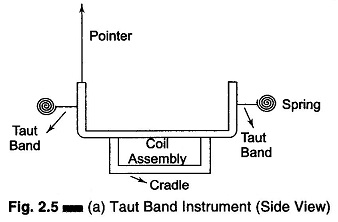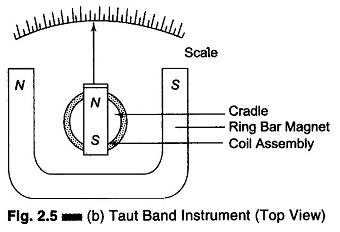Taut Band Instrument:
The Taut Band Instrument utilizes the same principle as the D’Arsonval movable coil and fixed magnet. The primary difference between the two is the method of mounting the movable coil.
The taut band movement has the advantage of eliminating the friction caused by a jewel-pivot suspension. The meter has a coil mounted in a cradle and surrounded by a ring-bar magnet, as shown in Fig. 2.5. The cradle is secured to a support bracket, which in turn is suspended between two steel taut bands (ribbon), i.e. the movable coil is suspended by means of two taut torsion ribbons. The ribbons are placed under sufficient tension to eliminate any sag. This tension is provided by the tension spring, so that the instrument can be used in any position.
The current to be measured is passed through the coil, thereby energizing it. The interaction of the magnetic fields deflects the cradle to one side and moves the pointer along the scale.
The movement of the cradle exerts a twisting force on the steel bands. These twisted bands supply the torque to return the pointer to zero, when no current flows. There are no bearings, and there is a constant level of sensitivity throughout the range of movement.
Taut Band Instrument have a higher sensitivity than those using pivots and jewels. In addition Taut Band Instrument are relatively insensitive to shock and temperature and are capable of withstanding greater overloads than PMMC or other types.

